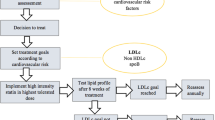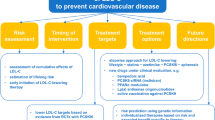Abstract
In the 1960s, epidemiologic studies established a link between elevated serum cholesterol and increased risk of cardiovascular events. Extensive clinical trial data subsequently highlighted 3-hydroxy-3-methylglutaryl coenzyme A reductase inhibitors (ie, statins) as the most effective pharmacotherapy for lowering low-density lipoprotein (LDL) cholesterol, and showed that statin-mediated LDL cholesterol reductions were associated with significant improvements in cardiovascular outcomes. Such findings are reflected in current cardiovascular disease management guidelines, which focus on LDL cholesterol as the primary therapeutic target. These guidelines recommend target LDL cholesterol levels. However, a number of clinical trials have failed to identify an LDL cholesterol threshold level below which no further cardiovascular risk reduction occurs. Such findings suggest that optimal risk reduction may require greater reductions in LDL cholesterol than are currently being achieved. This review examines recent data highlighting the benefits of more pronounced LDL cholesterol reductions and considers how this could be achieved in clinical practice when many patients are not even reaching current targets.
Similar content being viewed by others
References and Recommended Reading
Kannel WB, Castelli WP, Gordon T, McNamara PM: Serum cholesterol, lipoproteins, and the risk of coronary heart disease. The Framingham study. Ann Intern Med 1971, 74:1–12.
Neaton JD, Blackburn H, Jacobs D, et al.: Serum cholesterol level and mortality findings for men screened in the Multiple Risk Factor Intervention Trial. Multiple Risk Factor Intervention Trial Research Group. Arch Intern Med 1992, 152:1490–1500.
Stamler J, Wentworth D, Neaton JD: Is relationship between serum cholesterol and risk of premature death from coronary heart disease continuous and graded? Findings in 356,222 primary screenees of the Multiple Risk Factor Intervention Trial (MRFIT). JAMA 1986, 256:2823–2838.
Anderson KM, Castelli WP, Levy D: Cholesterol and mortality. 30 years of follow-up from the Framingham study. JAMA 1987, 257:2176–2180.
Assmann G, Schulte H: Relation of high-density lipoprotein cholesterol and triglycerides to incidence of atherosclerotic coronary artery disease (the PROCAM experience). Prospective Cardiovascular Munster study. Am J Cardiol 1992, 70:733–737.
Martin MJ, Hulley SB, Browner WS, et al.: Serum cholesterol, blood pressure, and mortality: implications from a cohort of 361,662 men. Lancet 1986, 2:933–936.
Shepherd J, Cobbe SM, Ford I, et al.: Prevention of coronary heart disease with pravastatin in men with hypercholesterolemia. West of Scotland Coronary Prevention Study Group. N Engl J Med 1995, 333:1301–1307.
Downs JR, Clearfield M, Weis S, et al.: Primary prevention of acute coronary events with lovastatin in men and women with average cholesterol levels. Results of AFCAPS/TexCAPS. JAMA. 1998, 279:1615–1622.
Sever PS, Dahlof B, Poulter NR, et al.: Prevention of coronary and stroke events with atorvastatin in hypertensive patients who have average or lower-than-average cholesterol concentrations, in the Anglo-Scandinavian Cardiac Outcomes Trial—Lipid Lowering Arm (ASCOT-LLA): a multicentre randomised controlled trial. Lancet 2003, 361:1149–1158.
Scandinavian Simvastatin Survival Study Group: Randomised trial of cholesterol lowering in 4444 patients with coronary heart disease: the Scandinavian simvastatin survival study (4S). Lancet 1994, 344:1383–1389.
Sacks FM, Pfeffer MA, Moye LA, et al.: The effect of pravastatin on coronary events after myocardial infarction in patients with average cholesterol levels. Cholesterol and Recurrent Events Trial investigators. N Engl J Med 1996, 335:1001–1009.
Heart Protection Study Collaborative Group: The MRC/BHF Heart Protection Study of cholesterol lowering with simvastatin in 20536 high-risk individuals: a randomised placebo-controlled trial. Lancet, 2002:360:7–22
The long-term intervention with pravastatin in ischaemic disease (LIPID) study group: Prevention of cardiovascular events and death with pravastatin in patients with coronary heart disease and a broad range of initial cholesterol levels: the long-term intervention with pravastatin in ischaemic disease (LIPID) study. N Engl J Med 1998, 339:1349–1357.
Shepherd J, Blauw GJ, Murphy MB, et al.: Pravastatin in elderly individuals at risk of vascular disease (PROSPER): a randomised controlled trial. Lancet 2002, 360:1623–1630.
Collins R, Armitage J, Parish S, et al.: MRC/BHF Heart Protection Study of cholesterol-lowering with simvastatin in 5963 people with diabetes: a randomised placebo-controlled trial. Lancet. 2003, 361:2005–2016.
LaRosa JC, He J, Vupputuri S: Effect of statins on risk of coronary disease: a meta-analysis of randomized controlled trials. JAMA 1999, 282:2340–2346.
Colhoun HM, Betteridge DJ, Durrington PN, et al.: CARDS investigators: Primary prevention of cardiovascular disease with atorvastatin in type 2 diabetes in the Collaborative Atorvastatin Diabetes Study (CARDS): multicentre randomised placebo-controlled trial. Lancet 2004, 364:685–696.
Baigent C, Keech A, Kearney PM, et al.: Efficacy and safety of cholesterol-lowering treatment: prospective meta-analysis of data from 90,056 participants in 14 randomised trials of statins. Lancet 2005, 366:1267–1278.
National Cholesterol Education Program: Third report of the National Cholesterol Education Program (NCEP expert panel on detection, evaluation, and treatment of high cholesterol in adults (adult treatment III). JAMA 2001, 285:2486–2497.
DeBacker G, Ambrosioni E, Borch-Johsen K, et al.: European guidelines on cardiovascular disease prevention in clinical practice. Eur Heart J 2003, 24:1601–1610.
Grundy SM, Cleeman JI, Merz CN, et al.: Implications of recent clinical trials for the National Cholesterol Education Program Adult Treatment Panel III guidelines. Circulation 2004, 110:227–239.
Pedersen TR, Olsson AG, Faergeman O, et al.: Lipoprotein changes and reduction in the incidence of major coronary heart disease events in the Scandinavian Simvastatin Survival Study (4S). Circulation 1998, 97:1453–1460.
Campeau L, Hunninghake DB, Knatterud GL, et al.: Aggressive cholesterol lowering delays saphenous vein graft atherosclerosis in women, the elderly, and patients with associated risk factors. NHLBI post coronary artery bypass graft clinical trial. Post CABG Trial Investigators. Circulation 1999, 99:3241–3247.
Taylor AJ, Kent SM, Flaherty PJ, et al.: ARBITER: Arterial Biology for the Investigation of the Treatment Effects of Reducing Cholesterol: a randomized trial comparing the effects of atorvastatin and pravastatin on carotid intima medial thickness. Circulation 2002, 106:2055–2060.
Smilde TJ, van Wissen S, Wollersheim H, et al.: Effect of aggressive versus conventional lipid lowering on atherosclerosis progression in familial hypercholesterolaemia (ASAP): a prospective, randomised, double-blind trial. Lancet 2001, 357:577–581.
Nissen SE, Tuzcu EM, Schoenhagen P, et al.: Effect of intensive compared with moderate lipid-lowering therapy on progression of coronary atherosclerosis: a randomized controlled trial. JAMA 2004, 291:1071–1080.
Kent SM, Coyle LC, Flaherty PJ, et al.: Marked low-density lipoprotein cholesterol reduction below current National Cholesterol Education Program targets provides the greatest reduction in carotid atherosclerosis. Clin Cardiol 2004, 27:17–21.
Cannon CP, Braunwald E, McCabe CH, et al.: Comparison of intensive and moderate lipid lowering with statins after coronary syndromes. N Engl J Med 2004, 350:1495–1504.
Koren M, Hunninghake D, on behalf of the ALLIANCE investigators: Clinical outcomes in managed-care patients with coronary heart disease treated aggressively in lipid-lowering disease management clinics: the ALLIANCE study. J Am Coll Cardiol 2004, 44:1772–1779
LaRosa JC, Grundy SM, Waters DD, et al., for the Treating to New Targets (TNT) investigators: Intensive lipid lowering with atorvastatin in patients with stable coronary disease. N Engl J Med 2005, 352:1425–1435.
Pedersen TR, Faergeman O, Kastelein JJ, et al.: High-dose atorvastatin vs usual-dose simvastatin for secondary prevention after myocardial infarction: the IDEAL study: a randomized controlled trial. JAMA 2005, 294:2437–2445.
Laufs U, Wasserman S, Hilgers S, et al.: Rapid effects on vascular function after initiation and withdrawal of atorvastatin in healthy, normocholesterolemic men. Am J Cardiol 2001, 88:1306–1307.
Heeschen C, Hamm CW, Laufs U, et al.: Withdrawal of statins increases event rates in patients with acute coronary syndromes. Circulation 2002, 105:1446–1452.
Thomas M, Mann J: Increased thrombotic vascular events after change of statin. Lancet 1998, 352:1830–1831.
Ford ES, Mokdad AH, Giles WH, Mensah GA: Serum total cholesterol concentrations and awareness, treatment, and control of hypercholesterolemia among US adults: findings from the National Health and Nutrition Examination Survey, 1999 to 2000. Circulation 2003, 107:2185–2189.
EUROASPIRE I and II Group: Clinical reality of coronary prevention guidelines: a comparison of EUROASPIRE I and II in nine countries. EUROASPIRE I and II Group. European Action on Secondary Prevention by Intervention to Reduce Events. Lancet 2001, 357:995–1001.
Hoerger TJ, Bala MV, Bray JW, et al.: Treatment patterns and distribution of low-density lipoprotein cholesterol levels in treatment-eligible United States adults. Am J Cardiol 1998, 82:61–65.
Pearson TA, Laurora I, Chu H, Kafonek S: The lipid treatment assessment project (L-TAP): a multicenter survey to evaluate the percentages of dyslipidemic patients receiving lipid-lowering therapy and achieving low-density lipoprotein cholesterol goals. Arch Intern Med 2000, 160:459–467.
Andrews TC, Ballantyne CM, Hsia JA, Kramer JH: Achieving and maintaining National Cholesterol Education Program low-density lipoprotein cholesterol goals with five statins. Am J Med 2001, 111:185–191.
Garmendia F, Brown AS, Reiber I, Adams PC: Attaining United States and European guideline LDL-cholesterol levels with simvastatin in patients with coronary heart disease (the GOALLS Study). Curr Med Res Opin 2000, 16:208–219.
Hollman G, Ek AC, Olsson AG: Only one of four patients with familial hypercholesterolaemia reach cholesterol treatment goals in primary prevention. J Intern Med 2004, 256:176–177.
Ito MK, Delucca GM, Aldridge MA: The relationship between low-density lipoprotein cholesterol goal attainment and prevention of coronary heart disease—related events. J. Cardiovasc Pharmacol Ther 2001, 6:129–135.
Andrade S, Walker AM, Gottlieb LK, et al.: Discontinuation of antihyperlipidemic drugs—do rates reported in clinical trials reflect rates in primary care settings? N Engl J Med 1995, 332:1125–1131.
Simons LA, Levis G, Simons J: Apparent discontinuation rates in patients prescribed lipid-lowering drugs. Med J Austr 1996, 164:208–211.
Dunbar-Jacob J, Erlen JA, Schlenk EA, et al.: Adherence in chronic disease. Ann Rev Nurs Res 2000, 18:48–90.
O’Connor PJ, Rush WA, Trence DL: Relative effectiveness of niacin and lovastatin for treatment of dyslipidemias in a health maintenance organization. J Fam Pract 1997, 44:462–467.
Gagné C, Bays HE, Weiss SR, et al., for the Ezetimibe Study Group: Efficacy and safety of ezetimibe added to ongoing statin therapy for treatment of patients with primary hypercholesterolemia. Am J Cardiol 2002, 90:1084–1091.
Pearson T, Denke M, McBride P, et al.: A community-based, randomized trial of ezetimibe added to statin therapy to attain NCEP ATP III goals for LDL cholesterol in hypercholesterolemic patients: the ezetimibe add-on to statin for effectiveness (EASE) trial. Mayo Clin Proc 2005, 80:587–595.
Ballantyne CM, Abate N, Yuan Z, et al.: Dose-comparison study of the combination of ezetimibe and simvastatin (Vytorin) versus atorvastatin in patients with hypercholesterolemia: the Vytorin Versus Atorvastatin (VYVA) study. Am Heart J 2005, 149:464–473.
Bays H: Ezetimibe. Expert Opin Investig Drugs 2002, 11:1587–1604.
Prescribing information for Zetia. Available at http://www.zetia.com/zetia/shared/documents/zetia_pi.pdf. Accessed April 12, 2006.
Jones P, Kafonek S, Laurora I, Hunninghake D: Comparative dose efficacy study of atorvastatin versus simvastatin, pravastatin, lovastatin, and fluvastatin in patients with hypercholesterolemia (the CURVES study) Am J Cardiol 1998, 81:582–587.
Marz W, Wollschlager H, Klein G, et al.: Safety of low-density lipoprotein cholesterol reduction with atorvastatin versus simvastatin in a coronary heart disease population (the TARGET TANGIBLE trial). Am J Cardiol 1999, 84:7–13.
Olsson AG, Eriksson M, Johnson O, et al.: A 52-week, multicenter, randomized, parellel, double-blind, double-dummy study to assess the efficacy of atorvastatin and simvastatin in reaching low-density lipoprotein cholesterol and triglycaride targets: the treat-to-target (3T) study. Clin Ther 2003, 25:119–138.
Jones PH, Davidson MH, Stein EA, et al.: Comparison of the efficacy and safety of rosuvastatin versus atorvastatin, simvastatin, and pravastatin across doses (STELLAR* trial). Am J Cardiol 2003, 92:152–160.
Schuster H, Barter PJ, Stender S, et al.: Effects of switching statins on achievement of lipid goals: measuring effective reductions in cholesterol using rosuvastatin therapy (MERCURY I) study. Am Heart J 2004, 147:705–712.
Shepherd J, Hunninghake DB, Stein EA, et al.: Safety of rosuvastatin. Am J Cardiol 2004, 94:882–888.
Brewer HB: Benefit-risk assessment of rosuvastatin 10 to 40 milligrams. Am J Cardiol 2003, 92(Suppl):23K-29K.
Prescribing Information for Crestor. Available at http://www.astrazeneca-us.com/pi/crestor.pdf. Accessed April 12, 2006.
Vidt DG, Cressman MD, Harris S, et al.: Rosuvastatin-induced arrest in progression of renal disease. Cardiology 2004, 102:52–60.
Davidson HH: Rosuvastatin safety: lessons from the FDA review and post-approval surveillance. Expert Opin Drug Saf 2004, 3:547–557.
FDA Response to a Citizen Petition on Crestor, 14 March 2005. Available at http://www.fda.gov/cder/drug/infopage/rosuvastatin/crestor_CP.pdf. Accessed May 25, 2005.
Author information
Authors and Affiliations
Corresponding author
Rights and permissions
About this article
Cite this article
Olsson, A.G. Are lower levels of low-density lipoprotein cholesterol beneficial? A review of recent data. Curr Atheroscler Rep 8, 382–389 (2006). https://doi.org/10.1007/s11883-006-0035-7
Issue Date:
DOI: https://doi.org/10.1007/s11883-006-0035-7




